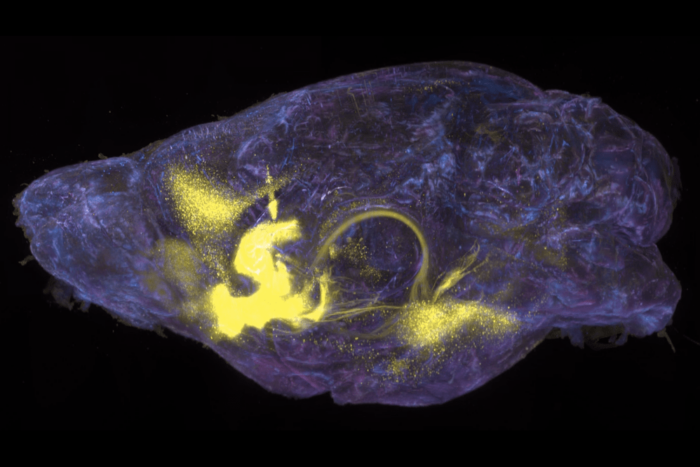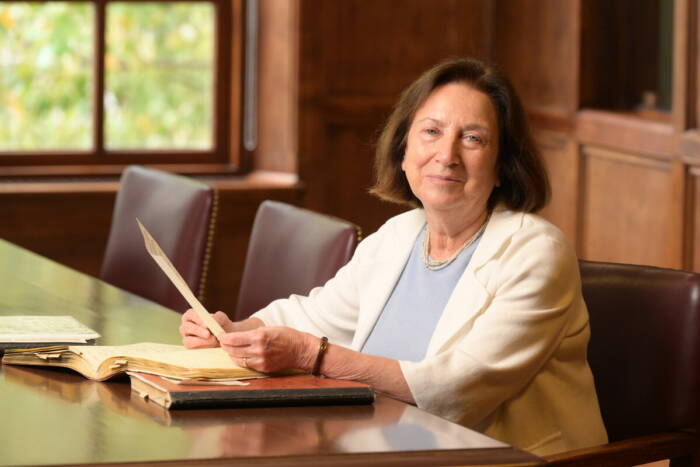White House Awards National Medal of Science to Rockefeller University's James Darnell
Nation’s highest scientific award honors gene regulation pioneer
 James E. Darnell Jr., M.D., a pioneering researcher in the field of gene regulation, will receive the National Medal of Science, the White House announced today. Darnell is among eight American scientists to receive the award, the nation’s highest honor for lifetime achievement in fields of scientific research.
James E. Darnell Jr., M.D., a pioneering researcher in the field of gene regulation, will receive the National Medal of Science, the White House announced today. Darnell is among eight American scientists to receive the award, the nation’s highest honor for lifetime achievement in fields of scientific research.
The 12th Rockefeller scientist to receive this award, Darnell will receive the National Medal of Science at a White House ceremony on Thursday, Nov. 6.
“Jim Darnell’s research has advanced our understanding about how genes in the nucleus of a body cell copy their instructions into a format that the cell’s internal machinery can translate at the right time and at the proper rate,” explains Paul Nurse, Ph.D., president of Rockefeller University since Sept. 1. The format is messenger RNA. The DNA in genes inside a cell’s nucleus sends its message to the cell’s protein-making machinery via messenger RNA.
Darnell’s many scientific achievements include the discovery of a pathway by which “molecular cues” on the outside surface of a cell signal the genes in that cell’s nucleus to take specific actions.
“These signals are sent in reaction to changes in the cell’s external environment in the body,” explains Nurse, a Nobel laureate. “As a result of the signals, the genes may express a message for a specific hormone or other protein, or halt gene expression or activation.
“Such communications contribute to the survival of cells and indeed the entire organism,” says Nurse.
The relevance of Darnell’s gene regulation research to human health is illustrated particularly by his relatively recent discovery of a cell-signaling route called the JAK-STAT pathway. This pathway has yielded important new insights into the biology of specific human cancers, including multiple myeloma and head and neck tumors.
“This discovery has promoted a flurry of research into the ways cells receive signals to become and remain specialized, to respond to growth factors and to deal with infection,” adds Nurse.
Darnell is the third Rockefeller University scientist in five weeks to be honored with a major award. On Sept. 19, Robert Roeder, Ph.D., received the Albert Lasker Award (“American Nobel”) for Basic Medical Research, and on Oct. 8, the Nobel Foundation in Sweden announced that Roderick MacKinnon, M.D., shares this year’s Nobel Prize in Chemistry.
An elected member of the National Academy of Sciences, Darnell joined Rockefeller University in 1974. He is the university’s Vincent Astor Professor and head of the Laboratory of Molecular Cell Biology. He also is a member of the university’s Pels Family Center for Biochemistry and Structural Biology.
Over the last 40 years, Darnell and his colleagues have supplied much of the evidence for the now generally accepted scientific concept that all RNA is formed by extensive “molecular carpentry.” His studies with ribosomal and transfer RNA, molecules that assist mRNA in directing protein formation, showed that both these molecules are chemically “processed” — chemical groups are added after synthesis and a long initial product is cut into usable pieces — before their use in the cell’s cytoplasm, the component of the cell that surrounds the nucleus containing the cell’s DNA code.
His studies on pre-mRNA from the DNA virus, adenovirus, paved the way for the Nobel Prize-winning discovery of RNA splicing in mRNA formation by Philip Sharp, Richard Roberts and their colleagues.
“For more than 40 years, Jim Darnell has had a major impact on American science,” Sharp wrote in a letter nominating the Rockefeller scientist for the Lasker honor. “He has played a unique role as a scientist, author and educator over this time.”
Perhaps the most far-reaching results from Darnell’s laboratory began with research in the early 1980s that culminated in 1992 with the mapping of the first complete “signal transduction” pathway: the JAK-STAT signaling pathway. Darnell’s group discovered that a set of dual function proteins, which they named STATs — for Signal Transducers and Activators of Transcription — remain quiescent in the cell until circulating polypeptides bind to specific receptors on the surface of the cell.
Specific STATs then are activated, pair up and travel to the nucleus to activate appropriate genes. For example, some STATs switch on a group of interferon-responsive genes when interferon contacts cells. Interferon, a cytokine used in anti-cancer and anti-viral therapy to halt or slow proliferation of cancer cells or viruses, is sometimes used in combination with chemotherapy.
Darnell’s lab also has shown that the persistent activation of a protein called Stat3 can, by itself, cause normal cells to behave like cancer cells. Scientists previously knew that Stat3 was often activated in various human cancer types, including lymphomas, leukemias, breast cancer and a high percentage of head and neck cancers, but Darnell and his colleagues showed for the first time that persistent Stat3 activation could contribute directly to the transformation of cells into tumor cells.
During the last 20 years, Darnell also has studied the coordinated control of sets of genes that are expressed mainly in liver cells. By studying the proteins responsible for liver-specific gene activation, he discovered a group of proteins that was also found to switch on specific genes very early in animal embryonic development.
Currently, Darnell and his colleagues at Rockefeller are exploring the molecular mechanisms by which STATs activate genes and why persistently active Stat3 contributes to cancer.
Besides advancing scientific understanding of the factors regulating activation or expression of genes in animal cells as models for human biology, Darnell has been a guiding force in helping to build a strong, stellar faculty at Rockefeller University. Beginning in the mid-1980s, working with then-President and Nobel laureate Josh Lederberg, he helped to establish more than 15 new junior faculty positions, each a head of a major laboratory at the university. Ten of the first 12 recruits in the program became full professors at Rockefeller, and more than 20 such young scientists have become tenured Rockefeller University professors through this effort.
Darnell received the Howard Taylor Ricketts Award of the University of Chicago Medical Center in 1979, the Scientific Achievement Award of the Department of Biochemistry of George Washington University in 1982, the Gairdner Foundation International Award in 1986, the Paul Janssen Prize in Advanced Biotechnology and Medicine in 1994, the Ernst W. Bertner Memorial Award in 1996 and the Passano Award in 1997, the Dickson Prize in 1999, the Novartis/Drew Award in Biomedical Research in 2000, and the Albert Lasker Award for Special Achievement in Medical Science.
He was elected a member of the National Academy of Sciences in 1973 and a foreign member of the Royal Society in 1996. He was named an honorary member of the Japanese Biochemical Society in 1997.
Darnell is the co-author of General Virology (with S.E. Luria) and founding author of Molecular Cell Biology (originally with Harvey Lodish and David Baltimore). This book is in its 5th edition. He has served on the editorial boards of many journals.
Over 120 doctoral and postdoctoral students have studied with Darnell, over 50 of whom are full professors and laboratory directors at research institutions throughout the world.
Darnell has been a member of several advisory bodies to the National Science Foundation, the National Institutes of Health and the American Cancer Society, and he is a member of the American Academy of Arts and Sciences.
Since the U.S. Congress established the National Medal of Science in 1959, a total of 12 Rockefeller University scientists have received this honor:
James E. Darnell Jr., 2002
Joshua Lederberg, 1989
George Palade, 1986
Paul A. Weiss, 1979
George K. Uhlenbeck, 1976
James A. Shannon, 1974
Frederick Seitz, 1973
Detlev W. Bronk, 1968
Fritz A. Lipmann, 1966
Peyton Rous, 1965
Donald D. Van Slyke, 1965
Theodosius Dobzhansky, 1964
Founded by John D. Rockefeller in 1901, The Rockefeller University was this nation’s first biomedical research university. Today it is internationally renowned for research and graduate education in the biomedical sciences, chemistry, bioinformatics and physics. A total of 23 scientists associated with the university have received the Nobel Prize in Physiology or Medicine and Chemistry, 19 Rockefeller scientists have received Lasker Awards, five have been named MacArthur Fellows and 12 have garnered the National Medal of Science. More than a third of the current faculty are elected members of the National Academy of Sciences.


